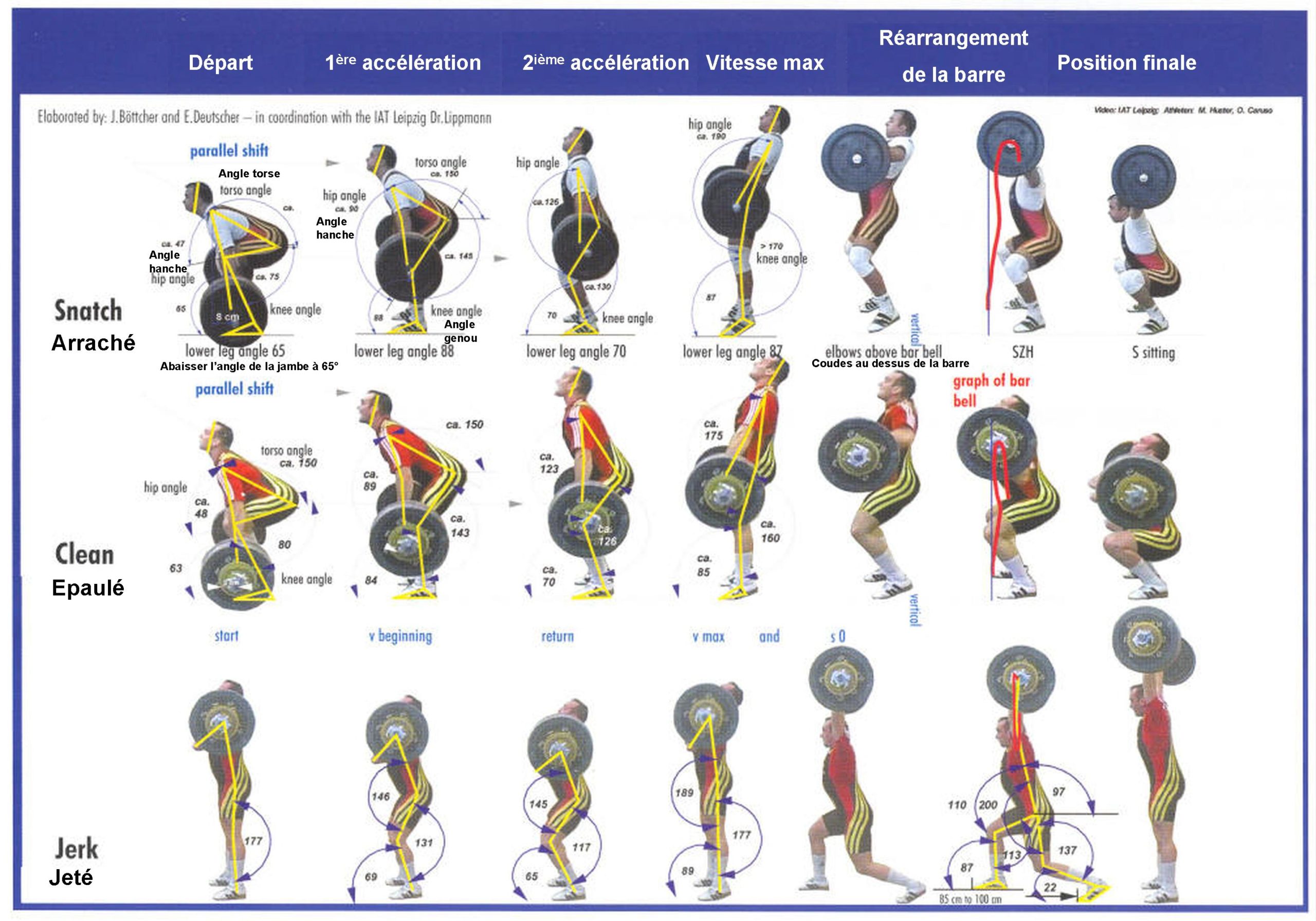
In my opinion the most effective single progressive resistance routine ever devised specifically for building the muscles of the back are progressive pulls. I was exposed to this routine around 1965 in an article in Strength & Health magazine. In the interceding decades I've added a few subtle twists. Anyone that I've gotten to use this program the way it is supposed to be used has gotten fabulous results.
Progressive Pulls will grow back muscle on a steel post and nothing more is needed than a barbell and a big pile of plates. This is hard and heavy work and if done correctly (regardless of your current degree of fitness) builds and strengthens every muscle on the human posterior. The sheer effort and intensity should knock the tar out of you physically. If it doesn't you are not doing the various pulls hard enough or heavy enough.
The human back is a complex conglomeration of large, medium and small muscles. Over time, nature and biomechanics have taught us unconsciously to allow the back muscles to act in a synchronized fashion in order to accomplish whatever muscular task is undertaken. To build a massive powerful back requires compound movements that take advantage of this naturally coordinated synchronization.
Ironically, nearly every "expert" recommends isolation exercises for the back. This common mistake ignores the back's biomechanical strengths and panders to its biomechanical weakness. The best way to blast the back is as a unit, and all at once, not piecemeal.
Let's examine the component parts:
The back muscles need to be shock-blasted using big, raw, sweeping, free weight exercises that cause the back muscles to work explosively and in sequential fashion. We pick movements done with two hands that require you to move a heavy object over a maximum rang-of-motion (ROM) pulling and tugging upwardly. This stimulates the back with a thoroughness that needs to be experienced. This is a timeless routine and all of us, regardless our level, need to perform this routine identically. The poundage used varies according to ability,, but technique does not.
A concentrated dose of progressive pulls does physiological wonders. This is a "Big Man" routine and as my comrade Kirk Karwoski might say, "Time to put away the pretty pick plastic Barbie dumbbells and get freaking serious!" Obviously a Purposeful Primitive will routinely perform this exercise sequence. If done with the requisite gusto this routine should only be done once a week. The idea is to establish initial poundage baselines in each exercise using crisp correct technique. Over time you increase poundage with no erosion or degradation of technique.
Increase poundage or reps on the top set of each exercise for six straight weeks (or longer). Avoid technical disintegration: if execution gets sloppy and you persist in continuing, nasty injury awaits you.
Welcome to the Thunderdome!
To make dramatic physical progress you will have to stroll into the pain zone. Actually the pain zone should more accurately be called the discomfort zone. Pain, real pain, is the indicator to immediately stop what you are doing.
You cannot trigger muscle hypertrophy (the irreducible root-core goal of progressive resistance exercise) by training sub-maximally. Unless you brush up against the lip of the limit envelope you can forget all about altering the shape of your body. The body does not favorably reconfigure itself in response to sub-maximal effort. Each day is different and limit capacity might differ significantly day to day, week to week. Regardless the limit of capacity on a particular day, If the stress imposed is not significant, nothing of significance will occur.
Limits can take many forms: reps, number of work sets, rest interval between sets, speed of the individual rep ... all could be used as stress inducers and stress benchmarks. Do you have to go to failure or use forced reps on the top set of every single exercise? No, absolutely not. There are no forced reps in this routine. Establish baseline benchmarks in each exercise and consciously and continually seek to improve. Plan ahead; project future performance using periodization principles. Here is a hypothetical poundage scenario for an "average" person. If you are stronger or weaker, alter the baseline benchmarks.

Over the life of the six week periodization cycle, reps are dropped and poundage increases. This routine peaks power and strength and triggers a concurrent increase in muscular size and is best used during a mass building phase. Taking in extra calories is highly advised. I would also advise average size men push their bodyweight up one pound a week in order to ensure positive nitrogen balance. Power training combined with ample calories and sufficient rest is the ticket for amassing massive back muscles.
Once you've build some muscle to work with, something worthy of defining, double back and "lean out" using a periodization program designed to melt off body fat. Let's acquire some muscle before we get hung up on ripped abs and shredded deltoids. Who cares about seeing ripped abs on some guy who looks like he just broke out of a Viet Cong prison camp. after being held in a tiger cage for six months? Who cares about defining a 14 inch arm? Here's a technical rundown on the lifts and their proper running order. Keep them in this sequence and on every rep of every set, strive for total technical perfection.
Progressive Pulls Technical Rundown
The starting position of the 1st four exercises is identical.
Sets: 2-3
Use a shoulder width stance and shoulder width grip. Squat down in a conventional deadlift start position. Step 1: Pull a light barbell upward in one fluid motion. The barbell is pulled straight up. Use a weight you can pull to shoulder height for 10 reps easily. Step 2: At the pulls peak, snap the wrists under, catching the barbell on the shoulders. Step 3: Stand erect cradling the bar. See photo sequence below.

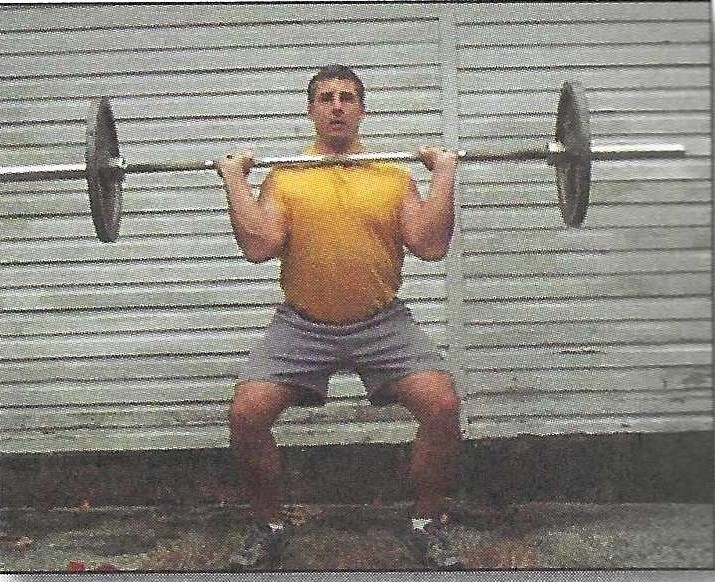
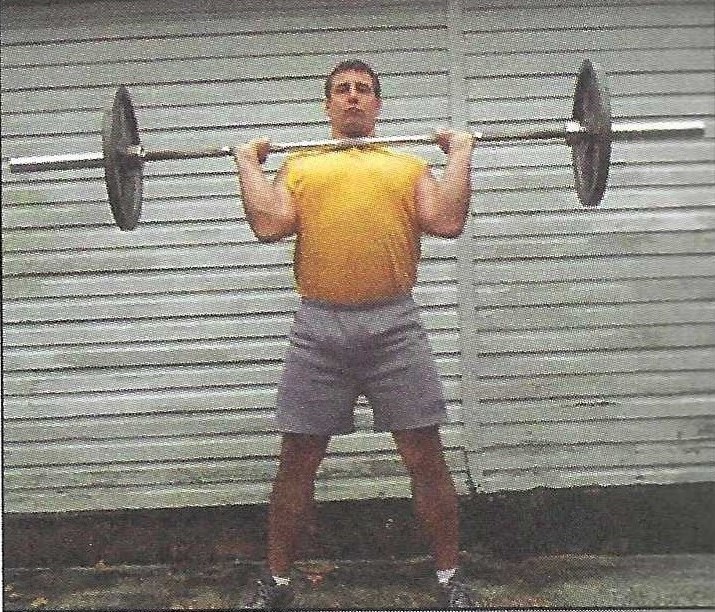
Increase poundage from Power Clean
Sets: 2-3
A High Pull is identical to a Power Clean. The difference being that the barbell is not being pulled high enough to wrist snap and rack it. Pull the barbell to the belly button height or higher each rep. Add poundage for each subsequent set. If the bar can only be pulled to crotch height - bag it. See photo or check out this YouTube video of a beginner high pull - https://youtu.be/gke61NfYUs0
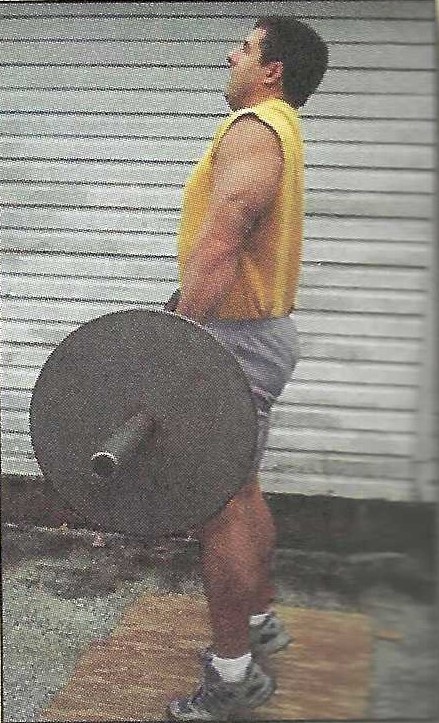
Increase poundage from High Pull
Sets: 2-3
Stand over top of a loaded barbell. Look down; you should be able to see your toes under the bar. Set feet 8 to 15 inches between the heels. Every muscle on the back is tense. Squat down until you can grasp the barbell with a shoulder width grip. The eyes look up. Using leg power alone, break the weight from the floor. The bar travels up the vertical shins, staying in continual contact with the shins and thighs before achieving lockout. The pull commences when the shoulders are directly over the bar in the lowest position. Pull upward in a straight line to completion. Lower the bar WITHOUT losing muscular tension. QUIETLY touch the weights on the floor before instantly reversing direction. See photo sequence below.
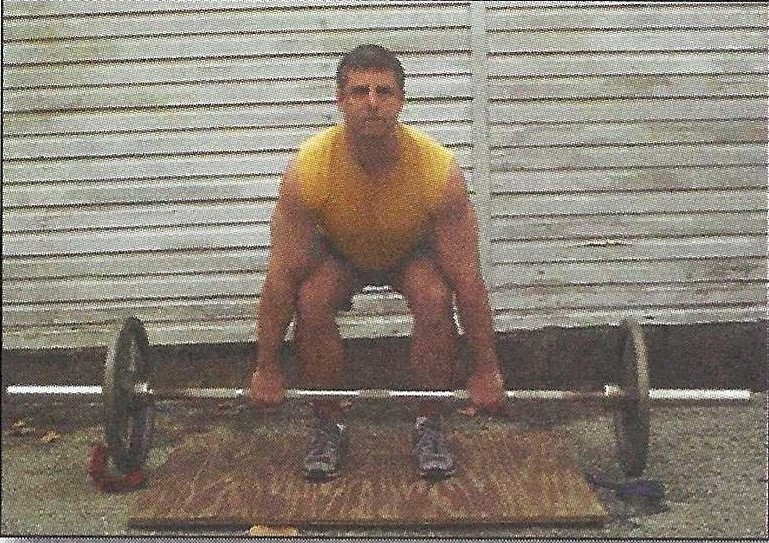
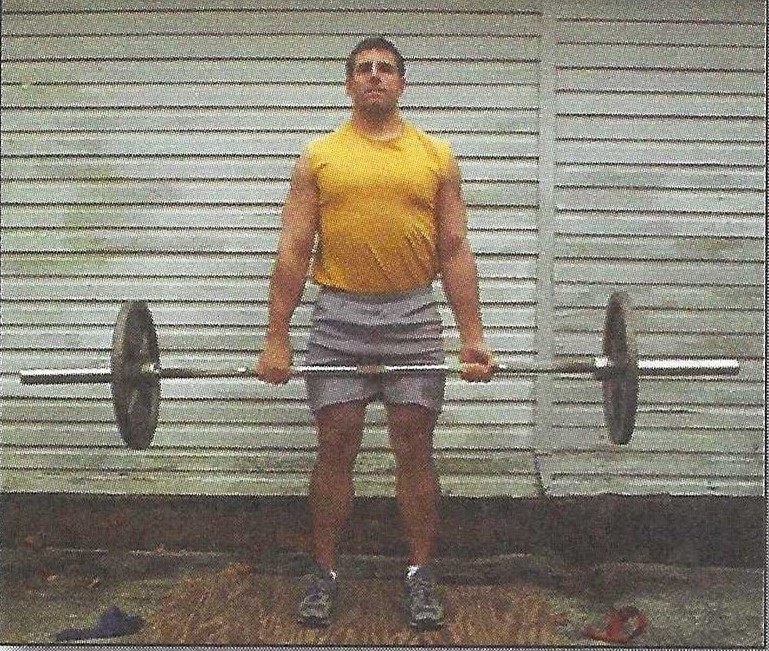
Decrease poundage by 35-50% from Conventional
Sets: 2-3
A stiff-legged deadlift is a lower back and hamstring developer without peer. Pull the first stiff-legged rep to completion using standard deadlift technique to set up. Stand erect with the bar in deadlift fashion on the 1st rep. Now lower the barbell downward on semi-straight yet rigid knees, allowing the bar to break away from the body. Lower slowly with straight arms until it touches the floor, gently. No bouncing the plates off the floor to create rebound. Upon touching the floor, quietly, begin an immediate rising up using a tight arched back. Pull to complete lockout. As you lower, pay attention and push the hips rearward. At the turn-around, where descent becomes ascent, use the hamstrings and lower back to power you erect. Think of the stiff-leg dead a "hip hinge" exercise. See photo.
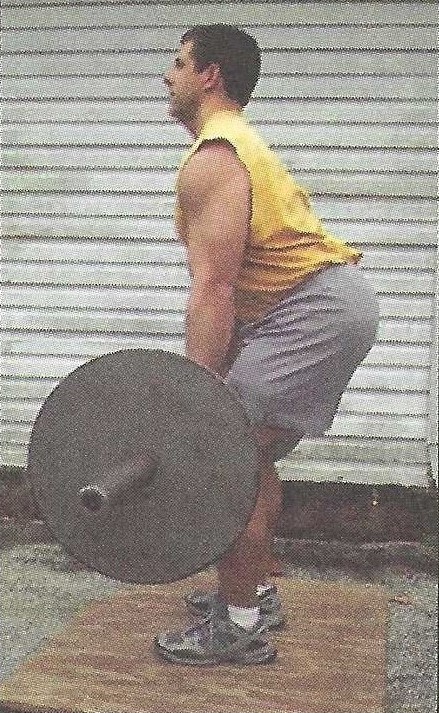
Decrease poundage by 25% from Stiff-Legged
Sets: 2-3
This is a terrific lat builder. Reach down and grab the barbell. Sit back in a similar fashion to the stiff-leg deadlift and create a frozen torso position. Once in position create enough tension that the barbell is actually held an inch off the ground. Be aware that rows can be "arm pulled" instead of "back pulled." Focus on pulling back and up with the elbows, not the biceps to isolate the lats. From the dead hang, pull the bar upward and touch the stomach. The torso stays parallel to the floor throughout. Do not dip and heave from the hip joint to get the bar moving that makes the lift easier and we want to make it harder. Try to hold the bar on the chest for a split second before lowering: this creates further contractions. In the set up grip widths can be altered to create different muscular effects: try a wide 32 inch grip and lighter poundage or an under-grip width. See photo sequence below.


You must Smart Bomb immediately after training in this fashion. Your battered back muscles are screaming out for regenerating nutrients. Drink a protein/carb liquefied shake to amplify workout results. This is not an option. I consume my shake after the deadlifts to forestall energy nosedives on stiffs and rows. So there you go ... a brutal back training program that works every single time it is performed in the way in which it was designed. If you want to build a powerful back you need to perform powerful exercises. Avoid the seductive traps of performing a few sets of lat pulldowns and seated cable rows, perhaps some effet machine pullovers and congratulating yourself on a GREAT back workout.
For more information on old school training mentors check out the posts below.
Learn more about our training philosophy check out our Progressive Resistance Resource Page. Join the community sign up below to our newsletter and receive our FREE Planning and Periodization Guide.
Want the inside training scoop?
Join The Community
Our email content is full of value, void of hype, never pushy, and always free. As a BONUS you will receive our FREE planning & periodization template to help you with your training goals.




[…] is best exemplified by large muscle movements: power cleans, high pulls, weighted or unweighted vertical jumps, heavy ball throws, sprinting. The […]